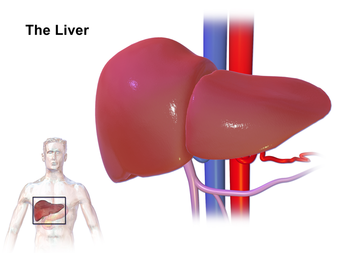Liver Function Tests: Difference between revisions
No edit summary |
No edit summary |
||
| Line 3: | Line 3: | ||
== Introduction == | == Introduction == | ||
Groups of blood tests performed to know the condition of a liver of a patient are known as liver function tests (LFT) or liver panel or hepatic function panel or hepatic panel.<ref>Teshome G, Ambachew S, Fasil A, Abebe M. [https://www.ncbi.nlm.nih.gov/pmc/articles/PMC6803769/ Prevalence of liver function test abnormality and associated factors in type 2 diabetes mellitus: a comparative cross-sectional study]. Ejifcc. 2019 Oct;30(3):303.</ref> | Groups of blood tests performed to know the condition of a liver of a patient are known as liver function tests (LFT) or liver panel or hepatic function panel or hepatic panel.<ref>Teshome G, Ambachew S, Fasil A, Abebe M. [https://www.ncbi.nlm.nih.gov/pmc/articles/PMC6803769/ Prevalence of liver function test abnormality and associated factors in type 2 diabetes mellitus: a comparative cross-sectional study]. Ejifcc. 2019 Oct;30(3):303.</ref> | ||
[[File:Liver organ.png|alt=Image showing liver|center|thumb|337x337px]] | |||
== Components of Liver Function Tests == | == Components of Liver Function Tests == | ||
| Line 90: | Line 91: | ||
|} | |} | ||
{{#ev:youtube|bFdTgty0T0I}}<ref>MedCram - Medical Lectures Explained CLEARLY. Liver Function Tests (LFTs) Explained Clearly by MedCram.com. Available from: https://www.youtube.com/watch?v=bFdTgty0T0I [Last accessed 29 November, 2020]</ref> | |||
{{#ev:youtube|bFdTgty0T0I}}<ref> MedCram - Medical Lectures Explained CLEARLY. Liver Function Tests (LFTs) Explained Clearly by MedCram.com. Available from: https://www.youtube.com/watch?v=bFdTgty0T0I [Last accessed 29 November, 2020]</ref> | |||
== References == | == References == | ||
Revision as of 12:09, 29 November 2020
Introduction[edit | edit source]
Groups of blood tests performed to know the condition of a liver of a patient are known as liver function tests (LFT) or liver panel or hepatic function panel or hepatic panel.[1]
Components of Liver Function Tests[edit | edit source]
| Alanine Transaminase (ALT); Normal value: 0-45 IU/L
Aspartate Transaminase (AST); Normal value: 0-35 IU/L[2] |
|---|
Causes of raised transaminases:
|
| Alkaline phosphatase (ALP); Normal value: 30–120 IU/l[2] |
|---|
Causes of raised ALP:
|
| Gammaglutamyl transferase (GGT); Normal value: 0 to 30 IU/L[2] |
|---|
Causes of raised GGT:
|
| Bilirubin; Normal value: 2 to 17 micromoles/L[2] |
|---|
Causes of isolated hyperbilirubinemia:
|
| Prothrombin time; Normal value: 10.9 to 12.5 seconds[2] |
|---|
Causes of prolonged prothrombin time:
|
| Albumin; Normal value: 40 to 60 g/L[2] |
|---|
| With progressive liver disease serum albumin levels fall, reflecting decreased synthesis. Albumin levels are dependant on a number of other factors such as the nutritional status, catabolism, hormonal factors, and urinary and gastrointestinal losses.[3] |
References[edit | edit source]
- ↑ Teshome G, Ambachew S, Fasil A, Abebe M. Prevalence of liver function test abnormality and associated factors in type 2 diabetes mellitus: a comparative cross-sectional study. Ejifcc. 2019 Oct;30(3):303.
- ↑ 2.0 2.1 2.2 2.3 2.4 2.5 Lala V, Goyal A, Bansal P, Minter D. Liver function tests. StatPearls. 2020 Apr 28.
- ↑ 3.0 3.1 3.2 3.3 3.4 3.5 Limdi JK, Hyde GM. Evaluation of abnormal liver function tests. Postgraduate medical journal. 2003 Jun 1;79(932):307-12.
- ↑ MedCram - Medical Lectures Explained CLEARLY. Liver Function Tests (LFTs) Explained Clearly by MedCram.com. Available from: https://www.youtube.com/watch?v=bFdTgty0T0I [Last accessed 29 November, 2020]







